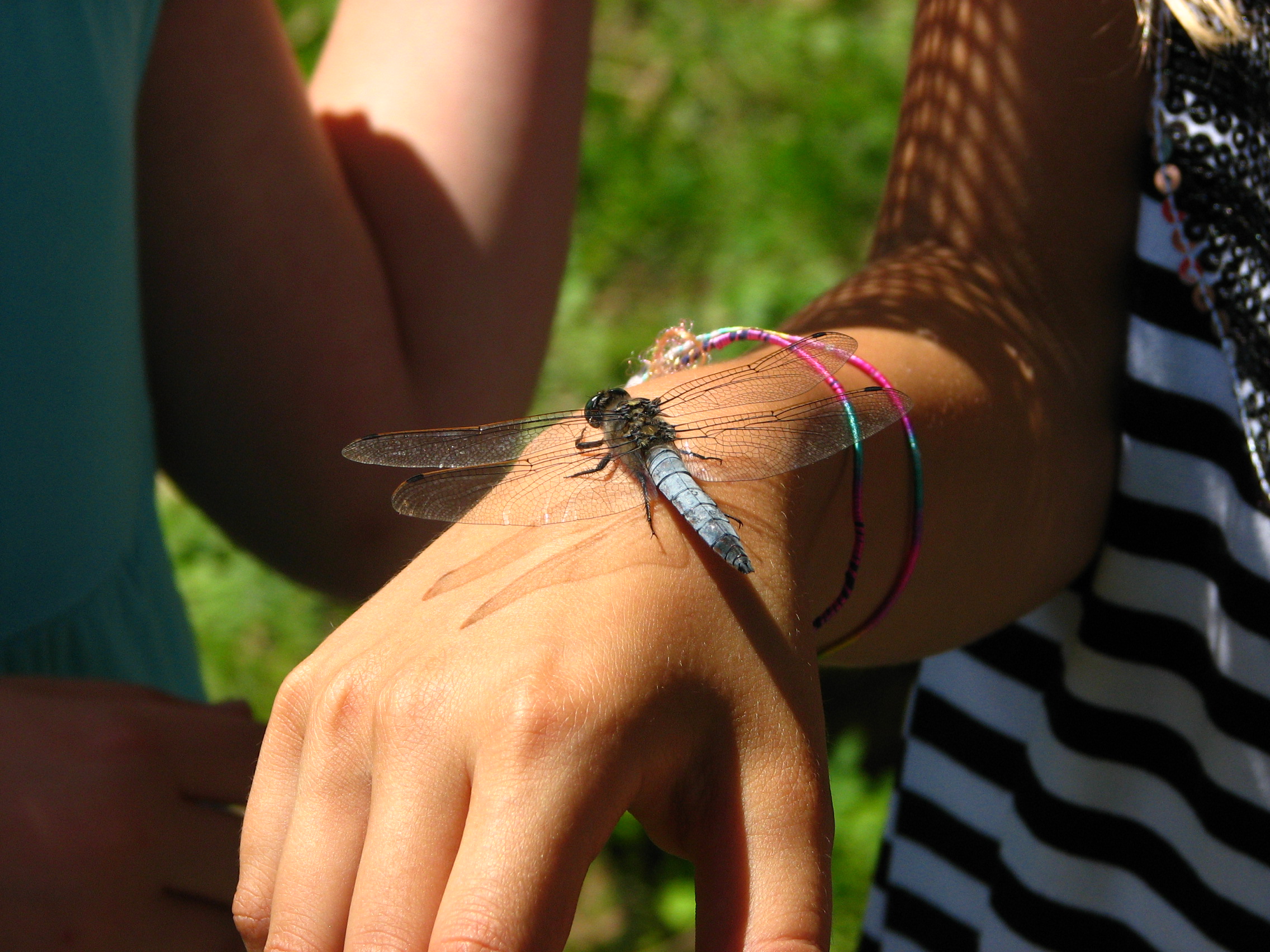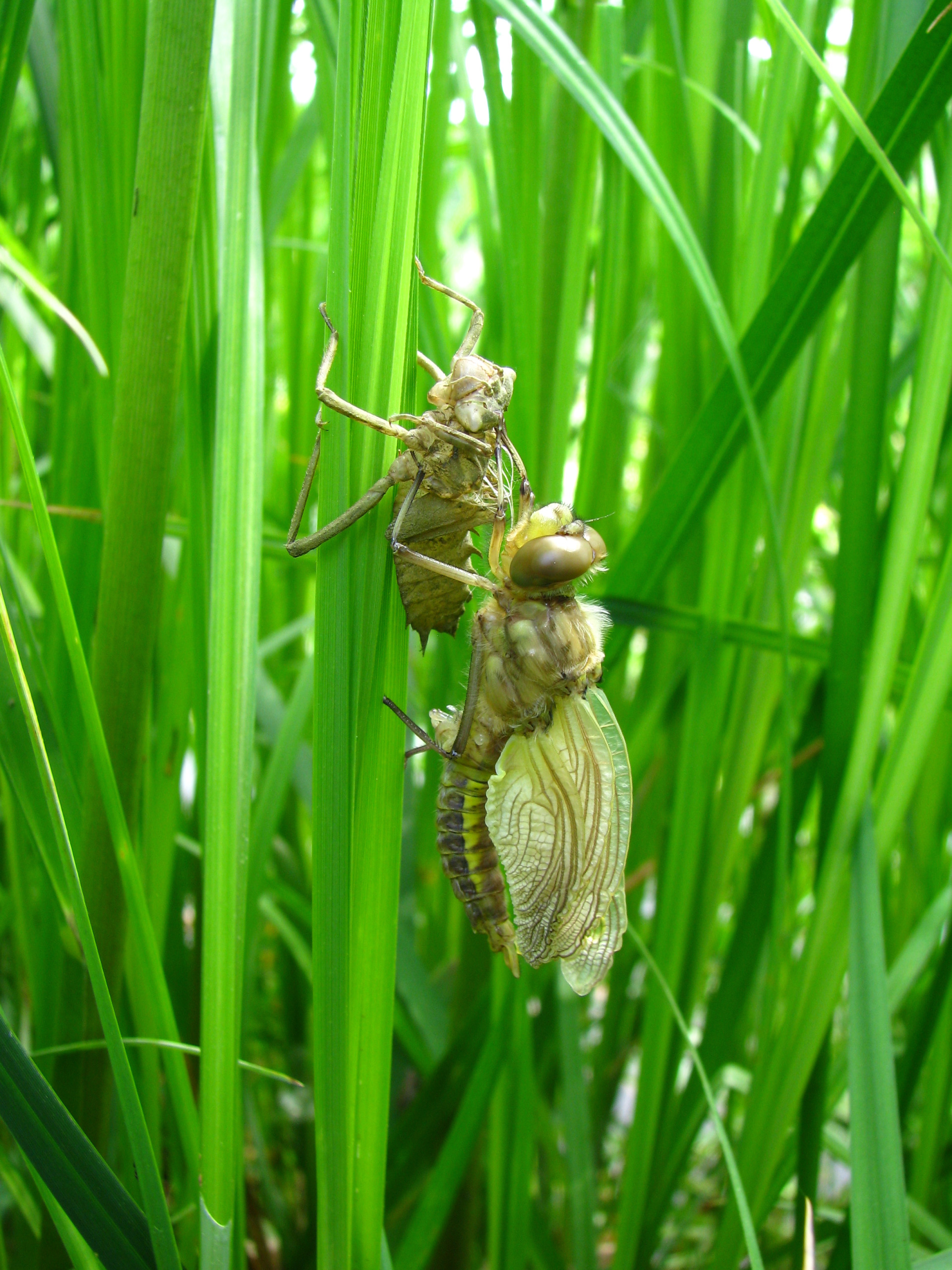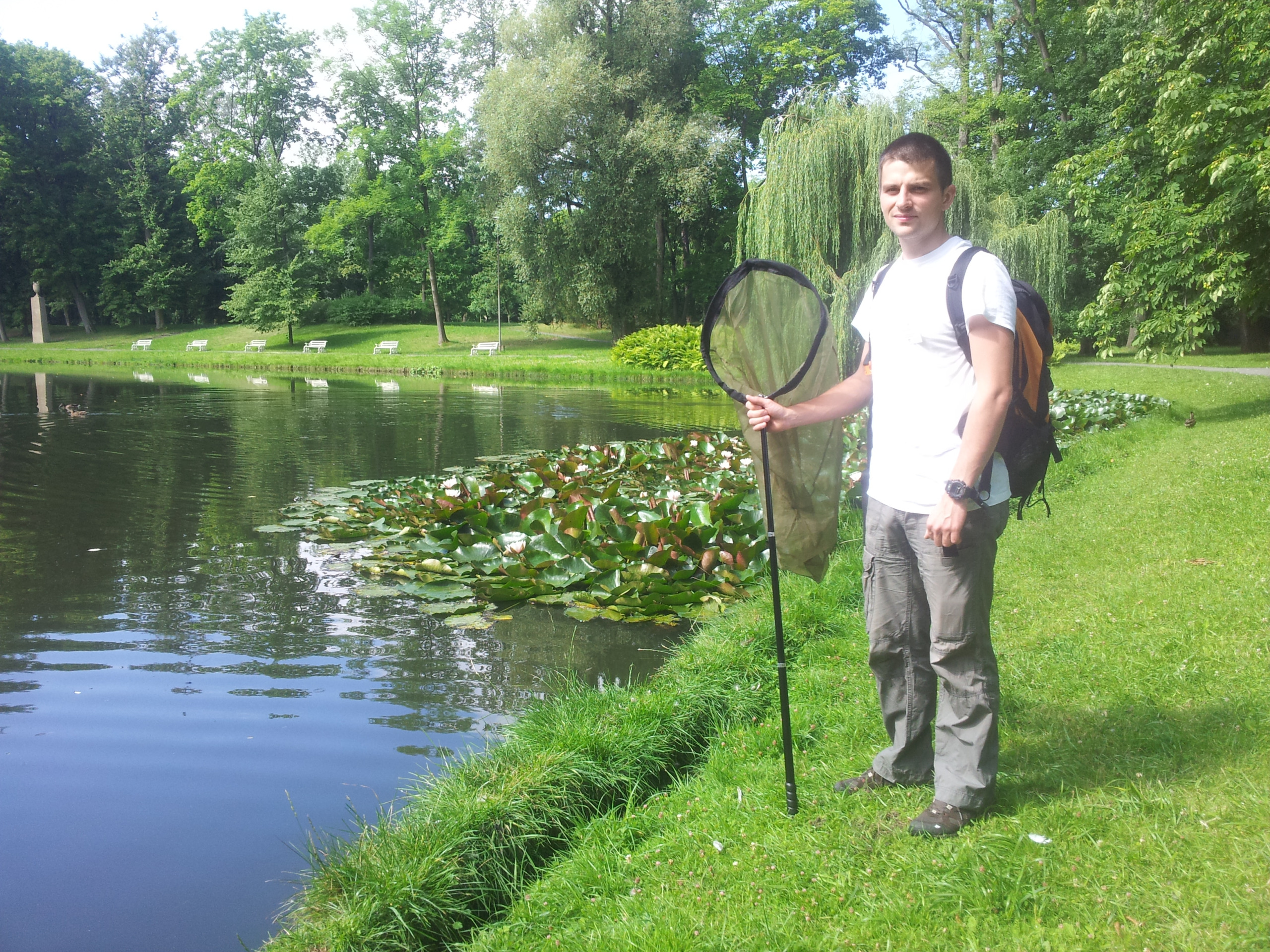Dragonflies – insects from the order Odonata (research results)
Dragonflies – insects from the order Odonata (research results)
One of the activities aimed at learning about the natural diversity of the Wilanów gardens was examining the species richness of dragonflies. The research was conducted on the South Pond, the Służewiecki Stream and on Lake Wilanowskie. In 2015, the research also covered the Sobieski Channel and other aquatic ecosystems of the Morysin nature reserve.
Research methodology
The species affiliation of adult insects was determined on the basis of real-life observations – trawling with an entomological net and the spotting method. The species composition of the larvae was also examined and moults were collected. Laboratory analysis of the moults was carried out in November 2015 after the completion of field research. The research was carried out at four sites divided into eight sections. As a result of the research, a list of observed species along with their estimated numbers was prepared.
What was observed
In November 2015, a final report summarising the work carried out was prepared. During the research, a total of 33 species of dragonflies were found in the entire area (including adult, larval and moulted forms). Almost all species were observed as adults. The exceptions were the Lestes sponsa and the hairy dragonfly, for which only larvae were caught. Moreover, in the case of 21 species, in addition to observing adults, larvae were caught and/or moults were collected. Considering the entire area included in the research, the indigenous occurrence was confirmed for most species. For 28 species, development was confirmed in at least one of the examined sections. In the study area, out of 15 protected species in Poland, only two protected species were found – the Siberian winterdamsel and the green hawker.
The site richest in dragonfly species was Lake Wilanowskie, where almost all taxa occurring in the entire study area were recorded (31 species; only the common clubtail and the yellow-spotted emerald were missing). The species composition and number of species differed between individual sections within this reservoir, although these differences were small. The second site in terms of the number of species was the Sobieski Channel with a fragment of the Wilanówka River, where 18 species were recorded (17 with at least probable development). In the case of the South Pond, 14 species were observed, all of them were assigned the development status of at least probable. However, the fewest species were recorded for the Służewiecki Stream – 13 species. At the same time, it was the site for which the largest number of species with the status of occurrence only were recorded (five species).
Taking into account the faunal similarity of dragonflies between individual sections, it was shown that the sites were clearly different. This is especially visible in the case of Lake Wilanowskie, the sections of which were characterised by a fauna quite similar to each other, while differing from other sites.
During research conducted in 2014–2015, 33 species of dragonflies were found in the entire area. This result expands the current knowledge regarding the occurrence of dragonflies in the study area. Taking into account data from previously conducted research and the results collected as part of the project, the number of species identified increased to 37.
To sum up, Lake Wilanowskie is certainly the best preserved environment for the occurrence and development of dragonflies in the entire study area. This is due to the presence of microhabitats in the water that are favourable for larvae and fragments of the shore characterised by a diverse structure of riparian vegetation. This condition is indirectly a result of the size of the reservoir itself. It should be noted, however, that slight qualitative and quantitative differences between individual sections were also observed.
The least favourable conditions for the development of dragonflies are found in the Służewiecki Stream. This is due to the generally poor condition of the entire river – it is regulated, in many sections the bottom is concreted, the banks are strengthened, the riparian vegetation is cut down and numerous pollutants are transported there from the urban areas through which it flows. The controlled section is an estuary fragment, therefore even improving the habitat conditions of this section would not result in an improvement in the condition of odonate fauna.
Partial research results
During observations carried out in October 2015, only 3 species of dragonflies were found. None of the observed species were observed as adults, only as larvae. These were the larvae of species such as: the red-eyed dragonfly, the blue-tailed damselfly, and the white-legged damselfly. Also during both inspections carried out in October, moults were collected from transects with a total length of 40 metres. The moults collected during this year’s research in November were carefully examined. Also using this research method, it is possible to determine which dragonflies occur in a given area. We will soon know the results of all the research work carried out as part of the project.
During research conducted in September 2015, 8 species of dragonflies were found (including both adult and larval forms). Six of the species identified were observed as adults: the blue hawker, the brown hawker, the migrant hawker, Chalcolestes viridis, the ruddy darter and the vagrant darter. However, two: the greater ophthalmia and the refined tetanus, only as larvae. During both field inspections carried out in September, moults (remains after transformation from larval to adult form) of dragonflies were collected from sections with a total length of 40 metres.
During research conducted in August 2015, 16 species of dragonflies were found (including both adult and larval forms). Fifteen of the identified species were observed as adults (the blue hawker, the brown hawker, the migrant hawker, banded demoiselle, common blue damselfly, red-eyed damselfly, small red-eyed damselfly, blue-tailed damselfly, Chalcolestes viridis, black-tailed skimmer, white-legged damselfly, brilliant emerald, spotted darter, ruddy darter, vagrant darter). However, one (small hawker) only as a larva. Of the two sections included in August, Lake Wilanowskie (the section running around the island) was slightly richer in species, where 13 species were recorded. In the section of the Sobieski Channel and the Wilanówka River, 11 species were found. Nevertheless, the species composition was quite similar for both transects. During both inspections carried out in August, moults were collected from transects with a total length of 40 metres. For both sites, a total of 20 metres of transects were searched in each of the examined sections.
During research conducted in July 2015, 16 species of dragonflies were found (including both adult and larval forms). Fifteen of them were observed as adults (the brown hawker, blue hawker, emperor, banded demoiselle, azure damselfly, variable damselfly, common blue damselfly, red-eyed damselfly, blue-tailed damselfly, four-spotted chaser, Chalcolestes viridis, black-tailed skimmer, white-legged damselfly, ruddy darter, vagrant darter), and one only as larvae (emerald). During two inspections carried out in July, moults (outer casings remaining after the transformation of dragonflies) were also collected from sections with a total length of 40 meters.
During research conducted in June 2015, a total of 18 species of dragonflies were found in the entire area (including both adult and larval forms). Seventeen species were observed as adults (red hawker, emperor, lesser emperor, banded demoiselle, azure damselfly, variable damselfly, downy emerald, common blue damselfly, red-eyed damselfly, blue-tailed damselfly, four-spotted chaser, Chalcolestes viridis, black-tailed skimmer, yellow-spotted emerald, white-legged damselfly, siberian winterdamsel, ruddy darter), and one only as larvae (emerald). The site richest in dragonfly species was Lake Wilanowskie, where 13 of them were recorded. The second in terms of the number of species was the section of the Sobieski Channel and the Wilanówka River, with 11 species recorded. Much fewer species of dragonflies, only five, were recorded for the Potok Służewiecki section. Four species were observed in the South Pond. During both inspections carried out in June, moults were collected from sections with a total length of 155 metres. In the case of Lake Wilanowskie, a total of 95 metres of transects were searched, while for the South Pond, the Służewiecki Stream and the Sobieski Channel it was 20 metres at each site, respectively.
During research conducted in May 2015, a total of 14 species of dragonflies (including both adult and larval forms) were found in the entire research area (Wilanów Gardens and the Morysin Nature Reserve). Eleven species among the above-mentioned were observed as adults (azure damselfly, variable damselfly, downy emerald, Eurasian baskettail, red-eyed damselfly, common clubtail, blue-tailed damselfly, four-spotted chaser, black-tailed skimmer, common winter damselfly, siberian winterdamsel), while the others were observed only as larvae (common blue damselfly, small red-eyed damselfly, yellow-spotted emerald). The site richest in dragonfly species was Lake Wilanowskie, where 12 of them were recorded. The second in terms of the number of species was the section that included the Sobieski Channel with the Wilanówka River, where seven species were found. Much fewer species of dragonflies, only three, were recorded for the Służewiecki Stream. However, only one species was observed in the South Pond. The species composition of dragonflies observed in the examined sections of Lake Wilanowskie differed slightly between them. A similar relationship also concerned the number of species found.
During research conducted in April 2015, a total of 6 species of dragonflies were found in the entire area. Two species were observed as adults - common winter damselfly and the variable damselfly, while the remaining species were observed only as larvae. The site richest in dragonfly species was Lake Wilanowskie, where 6 dragonflies were recorded. At the South Pond and at the Sobieski Channel, only one species was observed, while at the Służewiecki Stream no dragonflies were found during this research period. It is worth noting that no moults were recorded at any of the sites during this period. The moult is the outer, chitinous covering of the larva’s body, from which the adult emerges during metamorphosis.
In October 2014, a total of 7 species of dragonflies were found in the entire area (including both adult and larval forms). Three species of them were observed as adults (migrant hawker, ruddy darter, vagrant darter), while the remaining ones were observed only as larvae (banded demoiselle, variable damselfly, red-eyed damselfly, white-legged damselfly). The site richest in dragonfly species was Lake Wilanowskie, where 7 of them were recorded. Only one species (vagrant darter) was observed on the South Pond, while no dragonflies were found in the Służewiecki Stream during this research period.
During observations carried out in the entire area, the following occurrences were recorded: in July 2014 – 20 species of dragonflies, in August 2014 – 15 species of dragonflies, in September 2014 – 14 species of dragonflies.
The numbers given include both adult and larval forms. Most of the marked species occurred in the study area as adults, while some of them (brown hawker, banded demoiselle, variable damselfly, the red-eyed damselfly and the white-legged damselfly) were also caught as larvae. In some stages of the research, the occurrence of larvae of some dragonflies was recorded, the adults of which were not observed (from the order Phasmida, small hawker dragonfly, hairy dragonfly, variable damselfly, red-eyed damselfly, and the white-legged damselfly). The richest site in species was Lake Wilanowskie, then the South Pond, and the poorest site was the Służewiecki Stream.
During research conducted in 2014, 25 species of dragonflies were found in the entire area. This result adds new species to the known list of dragonflies in the area. A large part of the species observed in 2014 coincides with previous observations carried out in this area. The list of newly recorded taxa includes four species (southern hawker, lesser emperor, scarce chaser, Orthetrum albistylum and one genus for which it was not possible to assign it to a species (the order Phasmida). It is worth noting, however, that the scarce chaser and the Orthetrum albistylum received the status of only recorded occurrences, hence they could only be individuals that came from other populations. Six of the previously recorded species were not observed (emerald damselfly, downy emerald, broad-bodied chaser*, yellow-winged darter, black-winged darter*, northern white-faced darter*). This is most likely caused by several factors. Firstly, in 2014, only part of the area was covered by the research, while three of the species mentioned (above marked with *) were previously recorded only in the Morysin Nature Reserve, where the research will be carried out in 2015. The second reason is that the research began in July. In 2015, research will begin in spring, thanks to which we will obtain an even more complete picture of the richness of dragonflies in the Wilanów gardens.
The research on dragonflies was conducted by Tomasz Karasek, who says this about himself: I am a PhD student at the Department of Hydrobiology at the University of Warsaw. The main object of my scientific interests are freshwater macroinvertebrates. Currently, my research focuses on the use of these organisms in biological monitoring of freshwater environments. I am also interested in the faunistics and ecology of dragonflies, as well as predator-prey interactions occurring between aquatic invertebrates.




